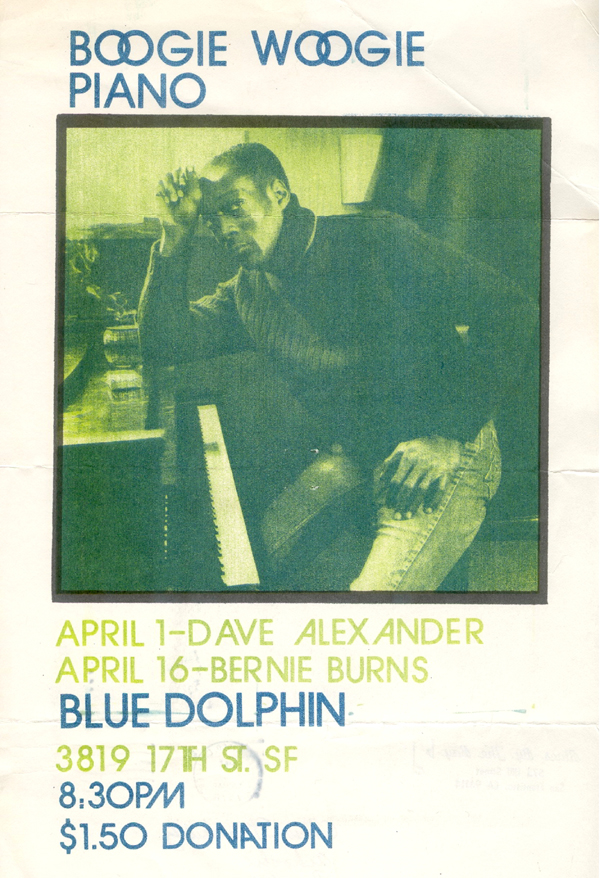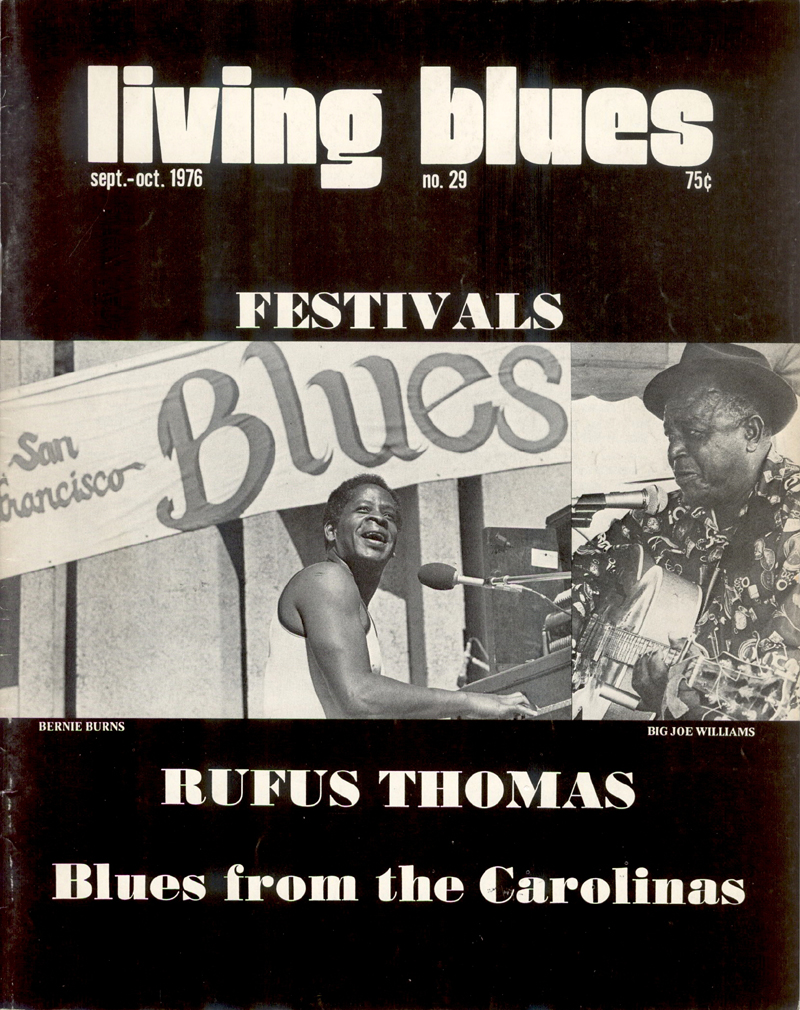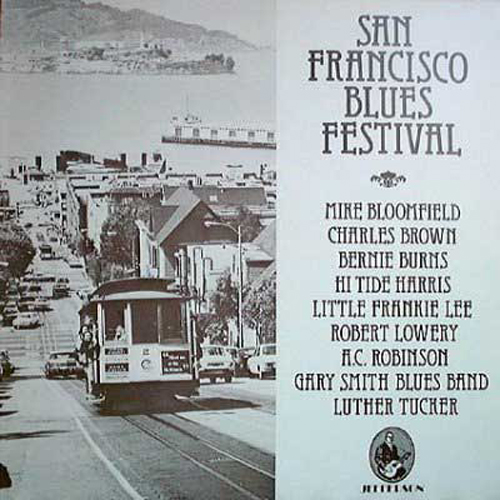
The Mysterious Bernie Burns and His Formless Boogie Woogie
by John Tennison, MD April 21, 2012 Copyright 2012
As a result of having researched the Boogie Woogie music of Omar Sharriff (AKA Dave Alexander), I learned about another piano player who was also performing Boogie Woogie in the San Francisco Bay Area in the 1970s. His name was Bernie Burns. I first encountered the name "Bernie Burns" on a poster from 1976 which advertised upcoming Boogie Woogie concerts at the Blue Dolphin Club in San Francisco by both Dave Alexander and Bernie Burns. Here is that poster:

On the Friday two days prior to the death of Omar Sharriff (on Sunday, January 8, 2012), I mentioned by phone to Omar that I had seen a poster which advertised him and a man named Bernie Burns performing Boogie Woogie at the Blue Dolphin Club in 1976. Although Omar responded that he recalled having performed at the Blue Dolphin Club, Omar told me that he did not recall anything about Bernie Burns.
Bernie Burns at the San Francisco Blues Festival
Although I was very familiar with Dave Alexander at the time I first saw the Boogie Woogie piano poster above, the name "Bernie Burns" on the poster made me curious. Upon further investigation, I learned that Bernie Burns had also performed Boogie Woogie and other styles at the 4th Annual San Francisco Blues Festival in 1976. Here is the poster from that year's San Francisco Blues Festival:

Bernie Burns in Living Blues Magazine
Upon further investigation, I uncovered a review of the 4th Annual San Francisco Blues Festival in Living Blues Magazine. In this review of the San Francisco Blues Festival in Living Blues #29 (1976), page 26, Lee Hildebrand wrote the following of Bernie Burns:
"The festival's big surprise this year was Bernie Burns, a natural entertainer if there ever was one. The muscular musician turned everybody's head around with a commanding one-man tour de force. Beginning with a crude, formless boogie piano assault, Burns switched to a repetitive country harp riff, then blew a small harp inside his mouth while clapping a hand-jive. "Outskirts of Town" was sung with revised lyrics in a high-pitched Little Richard-like wail and a lilting ragtime piece for piano and harp (simultaneously) brought Jelly Roll Morton to mind. Among Burns' other show-stopping effects were a Sonny Terry-styled harp-to-voice call and response and a spirited jig that ended with Burns on his knees in the audience."
In this same issue of Living Blues, there are two photos of Bernie Burns. One is on the cover, and the other is in the article by Lee Hildebrand on page 27. Here are those two photos:

Bernie Burns on page 27 of Living Blues, Issue 29, from 1976

A Crude, Formless Boogie Piano Assault
The comment by Lee Hildebrand that I found to be most compelling in the Living Blues review was Hildebrand's writing that Burns played "a crude, formless boogie piano assault." This description, although brief, was highly suggestive of the possibility that Burns was capable of playing in a way that more closely resembled the relatively unstructured and highly creative style of the earliest Boogie Woogie players. Such a way of playing stands in contrast to most professional Boogie Woogie players, whose repertoire is more reminiscent of the more-structured Boogie Woogie recordings that were so popular in the 1930s and 1940s. In general, structured ways of playing Boogie Woogie can be taught and such ways of playing are much more common among Boogie Woogie players. In contrast, the relatively less structured ways of playing Boogie Woogie are difficult to teach, and such ways of playing Boogie Woogie are more rare and usually more creative than that allowed for by the more structured traditions. Consequently, I reasoned that Bernie Burns could be an important Boogie Woogie player to seek out and record if he was still alive.
The Only Commercial Recording of Bernie Burns of Which I Know

Jefferson Records (named after Texas blues musician Blind Lemon Jefferson), is a Swedish label which released a 1977 album containing recordings of some of the performances at the 1976 SF Blues Festival. However, the album has only one piece by Bernie Burns. It is titled "Long Beach Stomp" and is the only commercially-released recording by Bernie Burns of which I know. Unfortunately, "Long Beach Stomp" is not Boogie Woogie, but rather, has more of a ragtime feel, with "oom-pah" bass figures, and does not exemplify a "crude, formless boogie piano assault" that Lee Hildebrand attributes to other material played by Bernie Burns at the 1976 SF Blues Festival. The title "Long Beach Stomp" suggests the possibility that Bernie Burns might have had some association with "Long Beach" (presumably Long Beach, California).
Communication with Tom Mazzolini, Founder of the San Francisco Blues Festival
Knowing that Burns had performed at the San Francisco Blues Festival, I contacted the founder of the San Francisco Blues Festival, Tom Mazzolini, in early 2012 to see if he could share anything he knew about Bernie Burns with me. I feared that Bernie Burns might not be alive. Mazzolini's response revealed more mystery about Bernie Burns than I had anticipated.
Tom Mazzolini wrote the following to me about Bernie Burns on February 6, 2012:
"Bernie Burns was a wonderful boogie-woogie pianist. I was then discovering new talent around the Bay Area and he was very good. However he was elusive and disappeared after the Festival never to be seen again. I heard he may have gone to Alaska."
Upon asking Tom Mazzolini for further recollections about Bernie Burns, Tom Mazzolini wrote the following to me on February 17, 2012:
"His wife or girl friend told me he was heading to Alaska. He also played harmonica. The album [the Jefferson Records album] had no liner notes except photos and musician listing. I don't know his Long beach connection. He was very secretive. He did not know Dave Alexander. Burns had no connection to the Oakland blues scene historically. He lived in Berkeley and performed in clubs and perhaps cafes. He was a mystery. We did photograph him. He was friendly and enthusiastic. He left town not long after his SFBF performance and was never heard from again. I can only assume he was not interested in fame or fortune. This sort of thing was not unusual back then. People can be quite complex and sometimes they are frightened by success and attention. Sometimes they have issues or things to hide. It was a great discovery at the time. Piano players of his caliber were hard to come by. he played many different styles. I remember emphasizing boogie-woogie and blues to him for his performance. I don't think he was from the Delta or Texas or some down-home spot. He was very expansive and culturally aware. His girlfriend was very astute and sounded disappointed about his departure. At the time I had no interest in going deeper over it with her. I sensed as I indicated that Burns was a traveler and that's all there was to it. Also this was so long ago and I've forgotten many details as I had so many other musicians to discover or find or work with. Maybe some facts will emerge eventually. Maybe his real name was something other. He put on a great show!"
As of April 21, 2012, the information above
is all I know about Bernie Burns. If anyone has any information about
Bernie Burns, I would love to hear from them at
nonjohn@yahoo.com or by phone at
210-884-0990.
Thank you Tom Mazzolini for sharing your recollections of Bernie Burns with me.